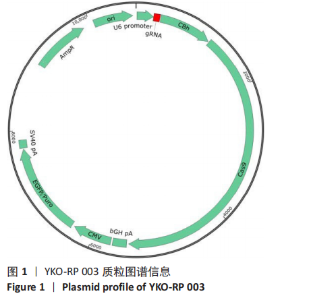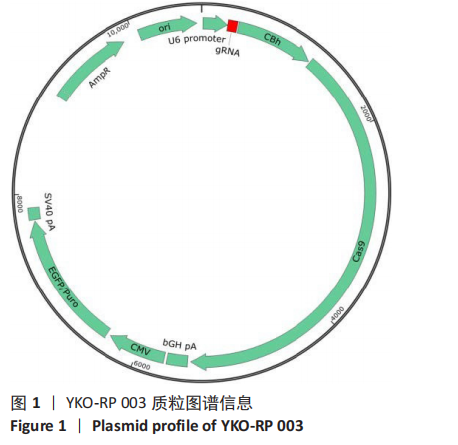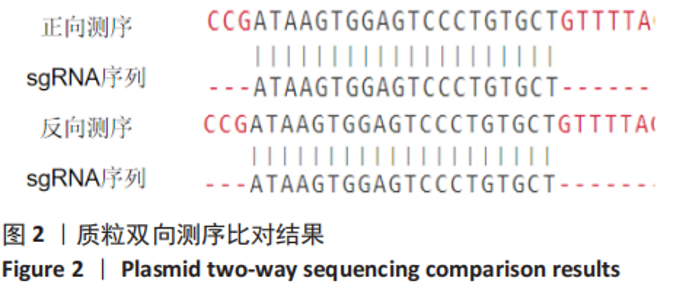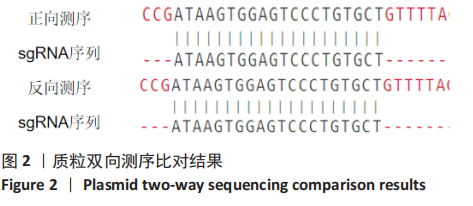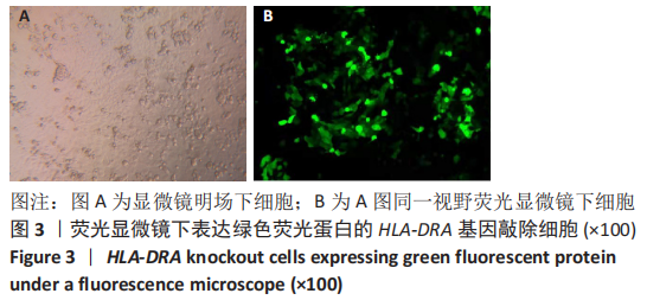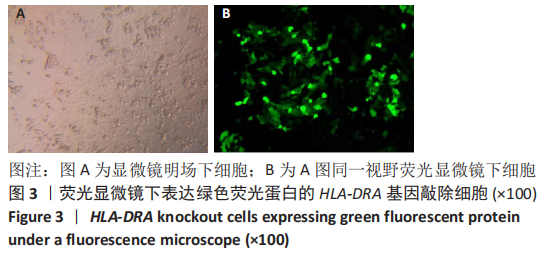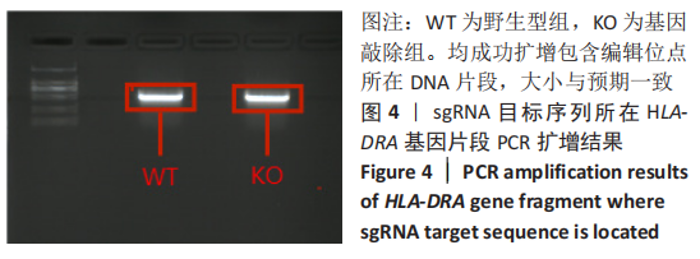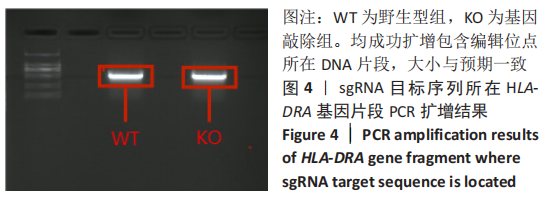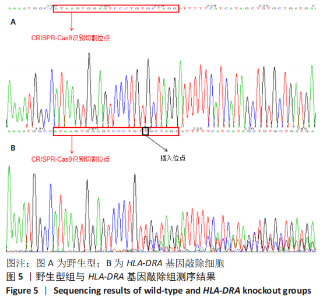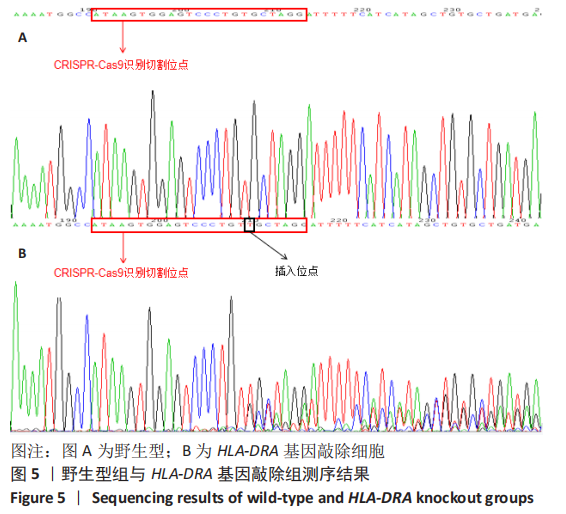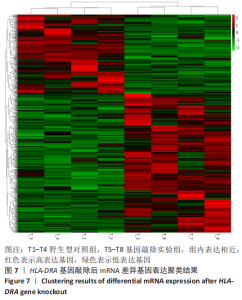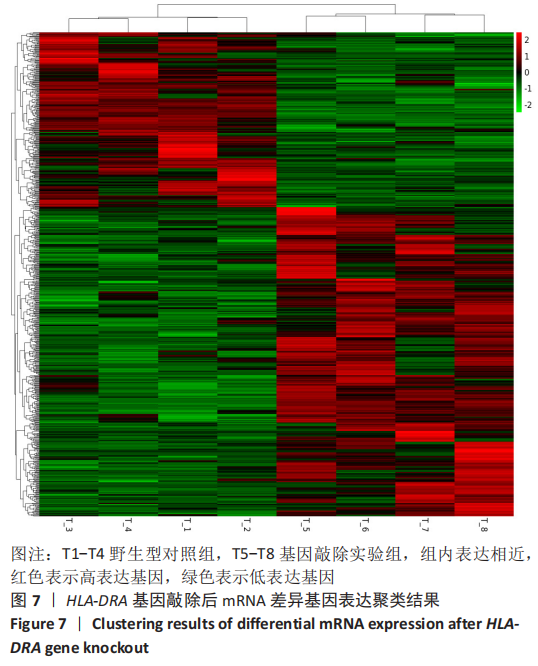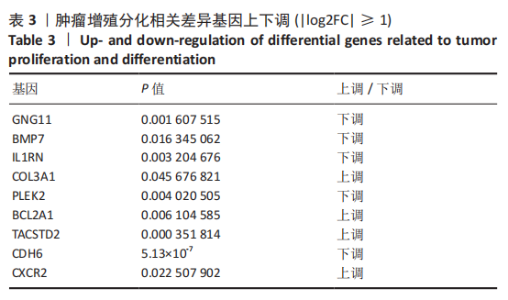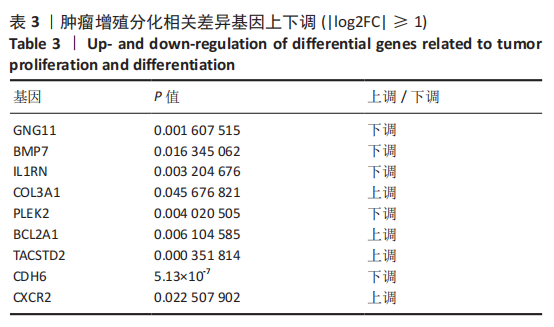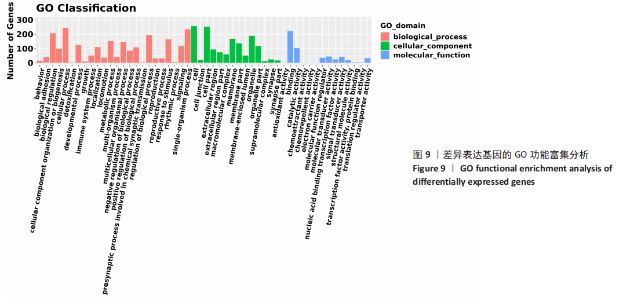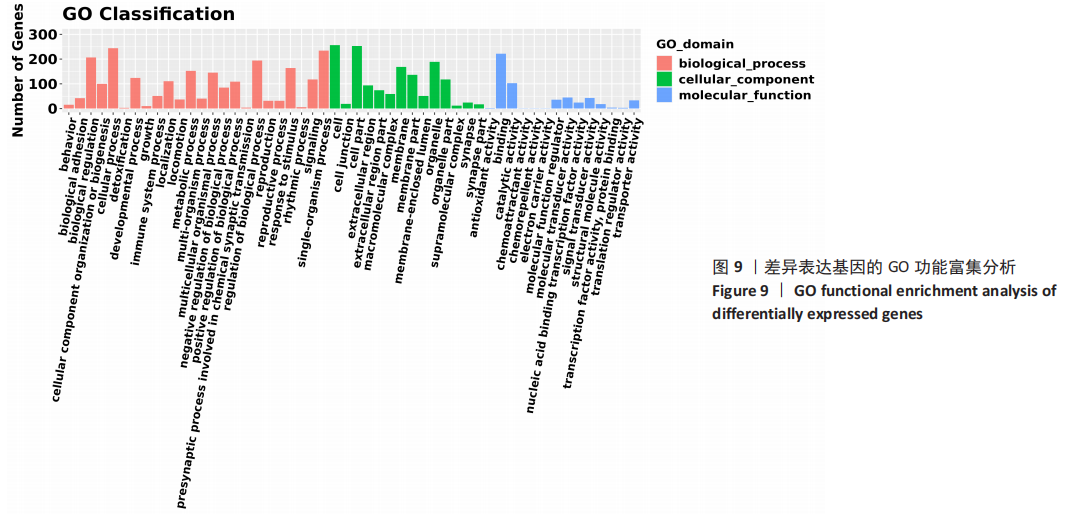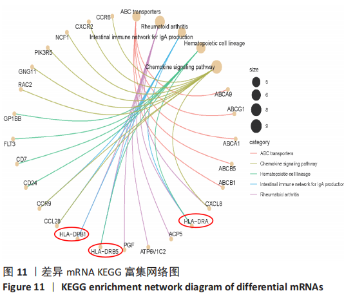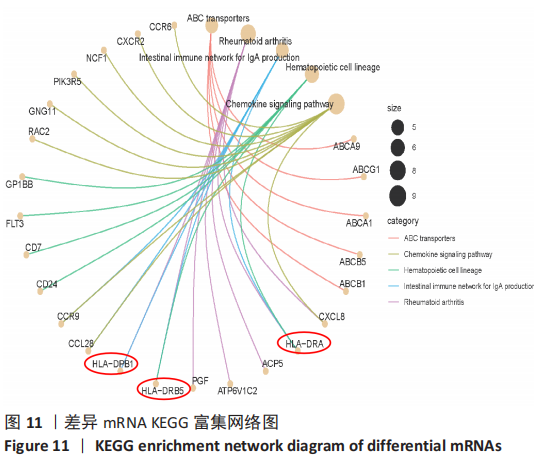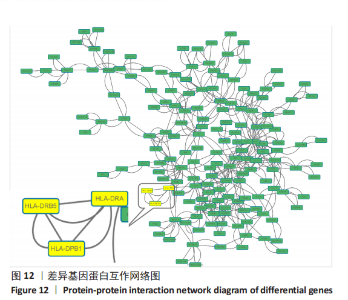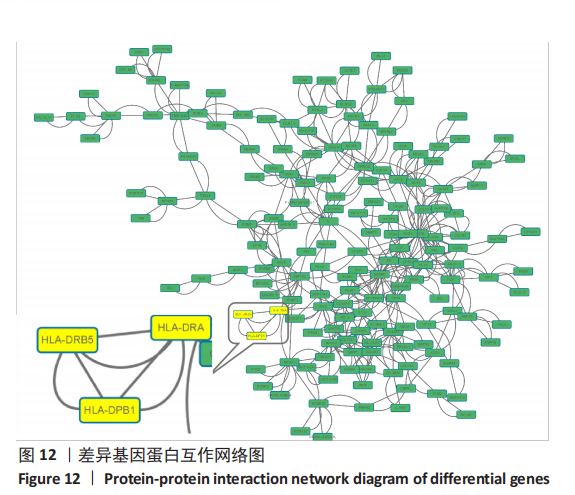Chinese Journal of Tissue Engineering Research ›› 2023, Vol. 27 ›› Issue (15): 2356-2362.doi: 10.12307/2023.622
Previous Articles Next Articles
Editing immune-related gene HLA-DRA for the first time by CRISPR/Cas9 technology combined with liposome transfection of endometrial cancer cells with single-plasmid gene knockout method
Cai Bo1, 2, Li Xiaoxiao1, 2, Zhang Linghan1, 2, Liu Yanxing1, 2, Mao Genhong1, 2
- 1Academy of Medical Sciences, Zhengzhou University, Zhengzhou 450014, Henan Province, China; 2Second Affiliated Hospital of Zhengzhou University, Zhengzhou 450014, Henan Province, China
-
Received:2022-05-23Accepted:2022-08-03Online:2023-05-28Published:2022-10-17 -
Contact:Mao Genhong, MD, Chief physician, Doctoral supervisor, Academy of Medical Sciences, Zhengzhou University, Zhengzhou 450014, Henan Province, China; Second Affiliated Hospital of Zhengzhou University, Zhengzhou 450014, Henan Province, China -
About author:Cai Bo, Master candidate, Academy of Medical Sciences, Zhengzhou University, Zhengzhou 450014, Henan Province, China; Second Affiliated Hospital of Zhengzhou University, Zhengzhou 450014, Henan Province, China -
Supported by:National Natural Science Foundation of China (General Program), No. 81971454 (to MGH)
CLC Number:
Cite this article
Cai Bo, Li Xiaoxiao, Zhang Linghan, Liu Yanxing, Mao Genhong. Editing immune-related gene HLA-DRA for the first time by CRISPR/Cas9 technology combined with liposome transfection of endometrial cancer cells with single-plasmid gene knockout method[J]. Chinese Journal of Tissue Engineering Research, 2023, 27(15): 2356-2362.
share this article
Add to citation manager EndNote|Reference Manager|ProCite|BibTeX|RefWorks
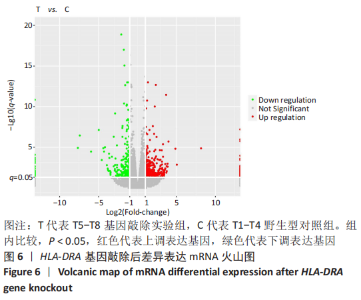
2.5 转录组测序质控及差异基因统计与筛选 HLA-DRA 基因敲除组(T5、T6、T7、T8)与野生型对照组(T1、T2、T3、T4)共8个样本完成转录组测序后,对获得的高通量测序结果进行质控。通过差异分析筛选,基因敲除组与野生型组相比,共筛选出686个差异表达基因,其中438个基因表达上调,248个基因表达下调。接下来对差异表达基因进行分析,为了更直观看出差异基因的整体分布情况,筛选阈值默认设置为Padj < 0.05绘制火山图,见图6。以不同实验条件下的差异基因的FPKM值为表达水平,做层次聚类分析,见图7,用于判断差异基因在不同实验条件下的表达模式。红色和绿色区域分别代表实验组与对照组聚类分组信息,同一颜色区域内可能具有相似的功能或表达模式相近,参与相同的生物学过程。与肿瘤增殖分化相关的差异基因表达情况见表3。"
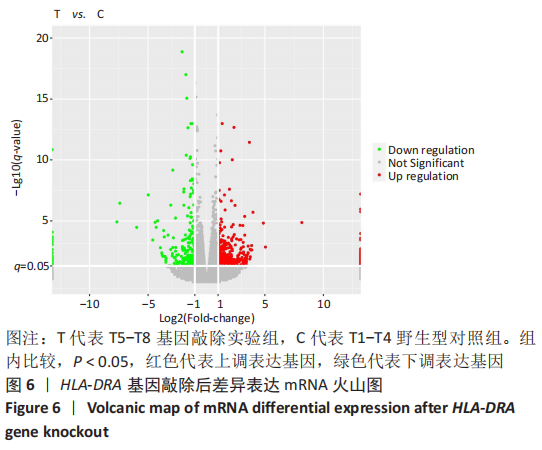
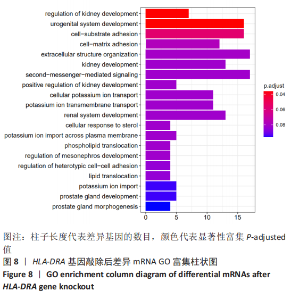
2.6 富集分析 2.6.1 GO富集分析 Gene Ontology(简称 GO,www.geneontology.org)是基因功能国际标准分类体系,可以根据筛选所得差异基因在Gene Ontology 中的分布得到实验样本差异在基因功能上的体现。 GO 富集分析方法为 GOseq[12],与超几何分布相比,能更准确地计算出 GO条目被差异基因富集的概率。 差异表达的mRNA在GO条目中富集,见图8。从生物学过程(biological process,BP)、细胞成分(cellular component,CC)、分子功能(molecular function,MF)3个不同层面解释基因的生物学功能,见图9。其中在生物学过程富集最显著,差异基因功能主要富集于泌尿生殖系统发育(GO:0001655)、细胞基质黏附(GO:0031589)、肾脏发育及调节(GO:0090183)、细胞外结构组织(GO:0043062)和第二信使介导的信号转导(GO:0019932)等;细胞成分主要定位于含胶原蛋白的细胞外基质(GO:0062023)、膜的细胞质侧(GO:0098562)、MHC Ⅱ类蛋白复合物(GO:0042613)、内质网内腔(GO:0005788)等;分子功能主要富集于细胞外基质结构成分(GO:0005201)、铁离子结合(GO:0005506)、钾离子跨膜转运蛋白活性(GO:0015079)、电压门控离子通道活性(GO:0005244)等。"
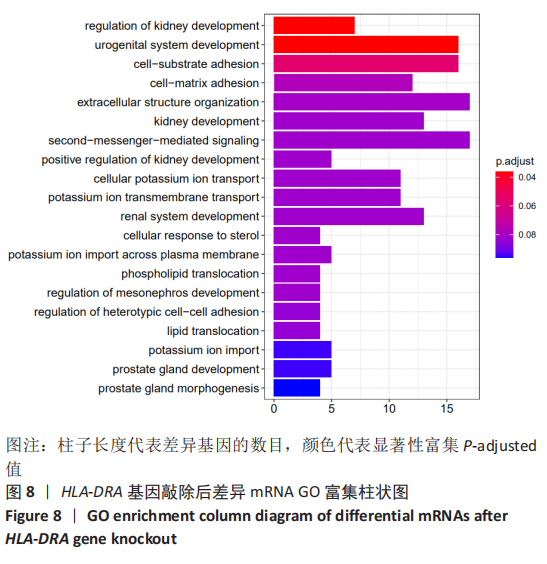
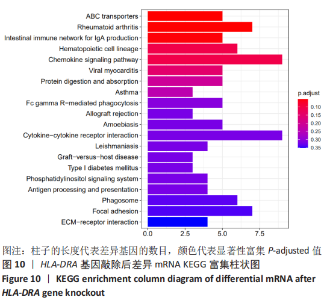
2.6.2 KEGG富集分析 KEGG (Kyoto Encyclopedia of Genes and Genomes)是有关通路的主要公共数据库[13]。通过将筛选出来的差异基因进行通路显著性富集,可以得到特异基因参与的最主要的信号转导和生化代谢途径。 KEGG富集程度通过Q值富集到此通路上的基因个数来衡量。P-adjusted值是做过多重假设检验校正之后的P值,P-adjusted值的取值范围为[0,1],越接近于零,表示富集越显著。 差异表达的mRNA在KEGG富集的前20主要富集于类风湿关节炎(hsa05323)、趋化因子信号通路(hsa04062)、造血细胞谱系(hsa04640)、腺苷三磷酸结合盒转运蛋白(hsa02010)、产生IgA的肠道免疫网络(hsa04672)、病毒性心肌炎(hsa05416)、蛋白质消化吸收(hsa04974)、哮喘(hsa05310)、FcγR介导的吞噬作用(hsa04666)、同种异体移植排斥反应(hsa05330)等通路,见图10,其对应的差异基因中参与度较高的有HLA-DRA、HLA-DRB5、HLA-DPB1、CXCL8、CCL28、CCR9等,其中HLA-DRB5和HLA-DPB1在HLA-DRA蛋白互作网络图中均表现出与HLA-DRA基因有较强的相关性,见图11,12。"
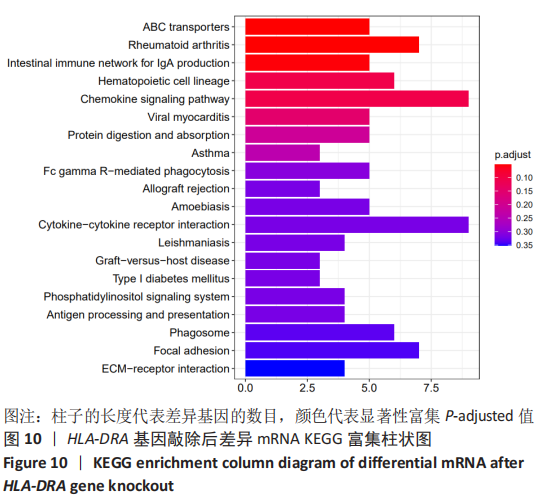
| [1] RAN FA, HSU PD, WRIGHT J, et al. Genome engineering using the CRISPR-Cas9 system. Nat Protoc. 2013;8(11):2281-2308. [2] HSU PD, LANDER ES, ZHANG F. Development and applications of CRISPR-Cas9 for genome engineering. Cell. 2014;157(6):1262-1278. [3] CONG L, RAN FA, COX D, et al. Multiplex genome engineering using CRISPR/Cas systems. Science. 2013;339(6121):819-823. [4] TANAKA K, HIGUCHI M, HANDO T, et al. Establishment and characterization of two histologically differentiated human uterine endometrial carcinoma cell lines from the same patient--a correlation between grade of morphological differentiation and HLA antigens. Nihon Sanka Fujinka Gakkai Zasshi. 1986;38(11):1975-1981. [5] RANGEL LB, AGARWAL R, SHERMAN-BAUST CA, et al. Anomalous expression of the HLA-DR alpha and beta chains in ovarian and other cancers. Cancer Biol Ther. 2004;3(10):1021-1027. [6] FENG T, ZHOU JH, LIU J, et al. Altered expression levels of HLA class and costimulatory molecules on circulating monocytes from patients with cervical intraepithelial neoplasia and squamous cervical cancer. Mol Med Rep. 2012;6(6): 1301-1304. [7] ALTOMONTE M, FONSATTI E, VISINTIN A, et al. Targeted therapy of solid malignancies via HLA class II antigens: a new biotherapeutic approach? Oncogene. 2003;22(42):6564-6569. [8] 安雯,潘四维,段石杰,等.基于GEO基质评分和免疫评分分析HLA-DRA在胃癌组织中的表达及其临床意义[J].中国医科大学学报,2021,50(12):1063-1068. [9] SARAIVA DP, JACINTO A, BORRALHO P, et al. HLA-DR in Cytotoxic T Lymphocytes Predicts Breast Cancer Patients’ Response to Neoadjuvant Chemotherapy. Front Immunol. 2018;9:2605. [10] DUNNE MR, PHELAN JJ, MICHIELSEN AJ, et al. Characterising the prognostic potential of HLA-DR during colorectal cancer development. Cancer Immunol Immunother. 2020;69(8):1577-1588. [11] MA J, ZHANG JK, YANG D, et al. Identification of novel prognosis-related genes in the endometrial cancer immune microenvironment. Aging (Albany NY). 2020; 12(21):22152-22173. [12] YOUNG MD, WAKEFIELD MJ, SMYTH GK, et al. Gene ontology analysis for RNA-seq: accounting for selection bias. Genome Biol. 2010;11(2):R14. [13] KANEHISA M, ARAKI M, GOTO S, et al. KEGG for linking genomes to life and the environment. Nucleic Acids Res. 2008;36(Database issue):D480-484. [14] TANG Z, LI C, KANG B, et al. GEPIA: a web server for cancer and normal gene expression profiling and interactive analyses. Nucleic Acids Res. 2017;45(W1): W98-W102. [15] RICHARDS EG, EL-NASHAR SA, SCHOOLMEESTER JK, et al. Abnormal Uterine Bleeding Is Associated With Increased BMP7 Expression in Human Endometrium. Reprod Sci. 2017;24(5):671-681. [16] FUKUDA T, FUKUDA R, MIYAZONO K, et al. Tumor Promoting Effect of BMP Signaling in Endometrial Cancer. Int J Mol Sci. 2021;22(15):7882. [17] 蒋永杰,寇邦国,边攀,等.PLEK2在恶性肿瘤中的表达及其对侵袭转移的影响[J].国际外科学杂志,2022,49(2):122-127. [18] 姜洪伟,胡琦,王举,等.COL3A1对胃癌细胞增殖及侵袭影响的实验研究[J].中国实验诊断学,2022,26(4):580-585. [19] VOGLER M. BCL2A1: the underdog in the BCL2 family. Cell Death Differ. 2012; 19(1):67-74. [20] CELIK SY, ÇELIK Öİ. Can TROP2 be used as a prognostic marker in endometrioid endometrial carcinoma? Indian J Pathol Microbiol. 2020;63(3):418-422. [21] GUGNONI M, SANCISI V, GANDOLFI G, et al. Cadherin-6 promotes EMT and cancer metastasis by restraining autophagy. Oncogene. 2017;36(5):667-677. [22] BARTOLOMÉ RA, ROBLES J, MARTIN-REGALADO Á, et al. CDH6-activated αIIbβ3 crosstalks with α2β1 to trigger cellular adhesion and invasion in metastatic ovarian and renal cancers. Mol Oncol. 2021;15(7):1849-1865. [23] 陆柏江,皇甫少华,江滨.CXCR2在肿瘤进展中的作用[J].中国肿瘤外科杂志, 2021,13(6):615-618,623. |
| [1] | Wen Hongjie, Chen Zhong, Yang Huagang, Xu Yongqing. Transcriptome sequencing analysis of osteogenic rat bone marrow mesenchymal stem cells induced by osteomyelitis [J]. Chinese Journal of Tissue Engineering Research, 2023, 27(15): 2333-2338. |
| [2] | Wang Xuejiao, Shi Wenjuan, Zhang Yan, Xing Dehai, Li Dongxue, Jiao Xiangying. Role of thioredoxin-interacting protein-mediated inflammatory response and apoptosis in myocardial infarction [J]. Chinese Journal of Tissue Engineering Research, 2023, 27(11): 1715-1721. |
| [3] | You Yihui, Song Chunhui, Chen Xi, Yao Xiaohong, Ke Junyu, Du Qun, Song Ning, Li Yanwu. Characteristic changes of intestinal mucosal morphology and transcriptomics in silent information regulator 6 gene knockout mice [J]. Chinese Journal of Tissue Engineering Research, 2022, 26(32): 5119-5125. |
| [4] | Wang Xiangyu, Zhu Ruizhi, Zhao Zhiping, Zhang Yuda, Zhang Yongtao, Wang Changyao. Construction of bromodomain-containing protein 4 gene knockout mice by CRISPR/Cas9 combined with Cre-loxP technology [J]. Chinese Journal of Tissue Engineering Research, 2022, 26(32): 5179-5184. |
| [5] | Sun Ying, Xiang Guangda, Xu Xiaoli. Effects of myeloid-derived growth factor on ventricular remodeling in aging mice [J]. Chinese Journal of Tissue Engineering Research, 2022, 26(31): 5020-5025. |
| [6] | Chen Xia, Shang Yuwei, Wang Linxiao, Shi Yichao, Liu Huijun, Sun Huiting. Transcriptome sequencing of the uterine in a mouse model of vitamin D deficiency [J]. Chinese Journal of Tissue Engineering Research, 2022, 26(26): 4101-4106. |
| [7] | Ding Yan, Xiang Guangda, Meng Biying, Xu Xiaoli, Chen Yuefu. Establishment and identification of a myeloid-derived growth factor deficiency model in apolipoprotein E knockout mice [J]. Chinese Journal of Tissue Engineering Research, 2022, 26(14): 2196-2201. |
| [8] | Zhou Quan, Zhang Yanan, Bai Yiguang, Zhang Qiong, Nong Haibin, Liu Mingfu, Zeng Gaofeng, Zong Shaohui. Effect of 3-phosphoinositide-dependent protein kinase 1 regulating osteoclasts on bone mineral density in osteoporotic mice [J]. Chinese Journal of Tissue Engineering Research, 2021, 25(29): 4680-4684. |
| [9] | Zhang Lishu, Liu Anqi, He Xiaoning, Jin Yan, Li Bei, Jin Fang. Alpl gene affects the therapeutic effect of bone marrow mesenchymal stem cells on ulcerative colitis [J]. Chinese Journal of Tissue Engineering Research, 2021, 25(25): 3970-3975. |
| [10] | Zhou Can, Yang Linan, Yang Kun, Liu Qi. Application status and prospect of induced pluripotent stem cell gene editing [J]. Chinese Journal of Tissue Engineering Research, 2021, 25(25): 4038-4044. |
| [11] | Mu Yufeng, Wei Lina, Wu Yong, Shao Anliang, Chen Liang, Qu Shuxin, Xu Liming. Development and evaluation of alpha-galactosyl antigen-deficient rabbit model [J]. Chinese Journal of Tissue Engineering Research, 2021, 25(2): 281-285. |
| [12] | Zheng Jiajun, Qing Wei, Huang Lijuan, Ren Jing, Liu Chunhui, Peng Pairan, Huang Jie, Mu Yandong . miRNA expression profiling of osteogenic differentiation of bone marrow mesenchymal stem cells induced by microchannel porous hydroxyapatite scaffold [J]. Chinese Journal of Tissue Engineering Research, 2020, 24(13): 1989-1995. |
| [13] | Ding Yan, Meng Biying, Xiang Guangda. Establishment and identification of a mouse model of vascular endothelial cell knockout DEPTOR gene [J]. Chinese Journal of Tissue Engineering Research, 2019, 23(23): 3698-3704. |
| [14] | Yuan Tao1, Wang Yongzhuo1, Huang Yuanzhang1, Xi Gang1, Wei Lei1, 2, Zhang Min1. Establishment of Indian hedgehog protein conditional knockout mouse models based on Cre/LoxP system [J]. Chinese Journal of Tissue Engineering Research, 2019, 23(19): 3013-3018. |
| [15] | Luo Su-yi, Huang Wei, Wang Jing, Wang Xi-yun, Li Jin-tao. Effects of tropomyosin 4 applied in spinal cord injuries via lentiviral vector recombination and the underlying mechanism: study protocol for a randomized controlled trial [J]. Chinese Journal of Tissue Engineering Research, 2016, 20(37): 5573-5579. |
| Viewed | ||||||
|
Full text |
|
|||||
|
Abstract |
|
|||||
